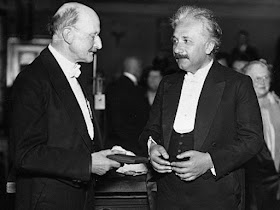I continue my excavations into physics and hope that you can conclude the NaPoWriMo successfully. Coming last it’s a pleasure to bring you something challenging.
At the end of the nineteenth century physicists believed that more or less everything was solved. Newton’s mechanics governed the law of particles and bodies, while optics could be explained through Maxwell’s theories of electromagnetism. The atomic theories have started to be developed, and it seemed that we could explain everything under the sun (and even beyond). By the way, a scientific theory requires evidence, it requires consistency and coherent observations. Newton’s laws and Maxwell’s equations are still valid enough to still be used in engineering.
But sometimes we find things that required new and updated theories. You have probably all heard about quantum physics and wondered about it. So let us go back to the roots. In 1905 Albert Einstein published a paper that later gave him the Nobel Prize in 1921. With his theoretical model he could explain the so called photoelectric effect.
The effect showed up as electrons emitted when an electrode was illuminated. The revolutionary model that Einstein proposed was that he attributed a particle properties to light. which has up to that point been described only as an electromagnetic wave obeying the laws of optics. But with the attribution of particle properties to light Einstein could explain and set up equations for the photoelectric effect. If you find this to be mumbo-jumbo, just skip it. The essence of this is the shapeshifting properties of matter. The particle wave dualism.
The concept was later broadened so that also particles can be waves. Particles can be refracted just like they are waves, and you can attribute both wavelength and frequency to them, just like light can have momentum.
So it goes both ways. A particle is a wave and a wave is a particle. In some cases we see particles governed by the laws of optics, and the next moment they are like little spheres.
Today I thought you could use this shape shifting nature of nature on microscopic level for a poem. Or you can chose to write about the consequences in terms of electronics and optics of the world today. Or challenge my belief that science can predict and used to decide the world.















